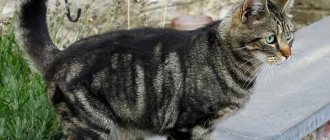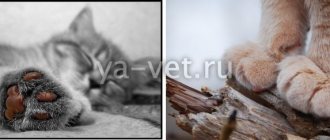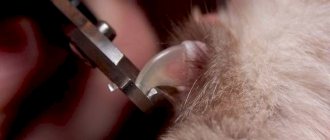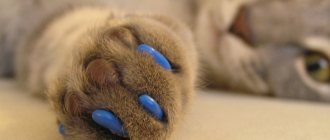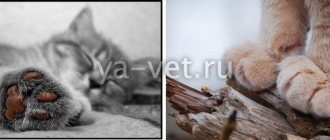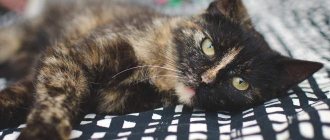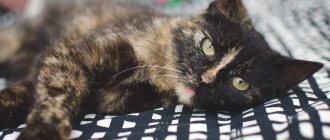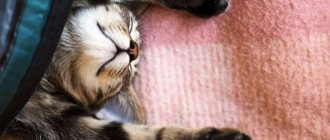If you have recently adopted a kitten or an adult cat into your family, then you probably want to learn as much as possible about your pet. You have most likely already paid attention to the habits of the new family member, his preferences and wondered why cats sleep at the feet of the owner, laying down there at will. Cats are amazing creatures; they choose a specific family member to sleep together, and not necessarily the one who feeds them and takes care of them. Below we will look at why purrs do this, and whether it is worth weaning them from the habit of sleeping on the bed at the feet of the owner.
Why does a cat sharpen its claws?
It is necessary to care for a cat’s claws from the first month of their life. They can sharpen their claws with their teeth and scratch walls and furniture with them - which can cause discomfort to their owners. Pets scrape off the dead outer shell of their claws in this way. Therefore, in an undesirable place where the animal scratched, you can find a “lost claw,” namely the very dead cornea of the claw.
Sharpening a cat's claws is a natural, necessary process.
In addition, by scratching various objects, the cat marks its territory. Not only by the remaining traces, but also by the secretion of the glands located on the back of the limbs. Their movements contribute to the release of this secretion with an odor and rubbing it into fabric or other things.
A kind of training for the claw release mechanism, which is important for grasping prey and climbing trees, is the reason why they scratch hard surfaces. This habit, characteristic of wild cats, has been preserved by them centuries later.
The cat sleeps at the feet, not nearby
The reasons why a cat lies down at a person’s feet to sleep may be the most banal:
- it is difficult to drive her away from this place if the owner does not like her neighborhood;
- the owner will not wake up the sleeping cat when he gets out of bed;
- the owner's feet are warm and there is no risk of being accidentally hit by a hand or foot when turning over from side to side of a sleeping person.
Most cat owners are not at all opposed to the fact that their pet sleeps with them in bed, curled up comfortably at their feet, believing that by doing so it removes negative energy, transforming it into positive energy, relieving illnesses and illnesses. There is some truth in this. Both cats and male cats mark not only the territory, but also the owner, by going to sleep at your feet, they show their love for him, demonstrate recognition and trust.
Veterinarians have their own opinion on this matter. They explain the desire of the purr to sleep at the feet of the owner by the desire for comfort and warmth. Bioenergetics specialists consider such desires of cats to be a desire to rid the owner of negative energy that accumulates in his lower legs due to its passage through the entire body.
The answer to the question of why a cat sleeps at a person’s feet, according to scientists, lies in the hierarchical nature of the animals’ relationships with each other and with the owner. Cats do not claim leadership positions in the family and therefore are content with a place at the feet of the owner, which serves as a kind of recognition of him as a leader and leader. They are not bothered by a person's tossing about in their sleep, changing positions, or turning over on their side.
The structure of a cat's skeleton and its joints
The skeleton plays the role of a frame made of bones (a cat has about 240 of them) and has 2 sections: axial and peripheral.
The skeleton of a cat has about 240 bones
The axial section includes:
- The spine consists of 30 vertebrae, which are divided into 5 sections. The cervical vertebrae are large and allow the cat to turn its head almost 180 degrees without changing body position. The tail also belongs to the spine; it allows you to maintain good balance when jumping and falling.
- The chest consists of 12 pairs of ribs.
- Cat skull. Unlike other mammals, cats have a short skull, and the size of the head in relation to the size of the entire body is small. Conventionally, the skull can be divided into 2 parts:
- facial, on which 13 bones are located;
- cranial, which contains 11 bones. The bones of the skull are stronger and larger than the facial part. The cat has a powerful jaw. Its main attribute is teeth. An adult animal has 30 of them. But even a kitten at the age of 3-4 weeks already has 26 sharp teeth. At 5–6 months, complete replacement of baby teeth with molars occurs.
The peripheral section includes the fore and hind limbs.
There are 5 toes on each of the front paws, and 4 on the hind paws. Each toe ends in a sharp claw, hidden in a so-called pouch when at rest.
The cat only releases its claws when necessary.
Cat joints are divided into:
- sutures that form between the fused bones of the skull and consist of hard fibers, devoid of mobility;
- cartilaginous, which consist of durable cartilage; in cats, these compounds are more flexible and mobile than in other animals;
- synovial - these are connections between two or more bones, providing them with greater mobility, the main types of such connections: spherical,
- articulated.
What time can an animal have its claws removed?
Cat claws are an integral part of a natural lifestyle. They are needed for successful hunting, tree climbing, and self-defense. Unfortunately, some owners prefer cleanliness, order, intact furniture and wallpaper, so they turn to veterinarians with a request to remove the claws of their pet. This operation is called onychectomy. This very complex surgical procedure involves amputating the cat's phalanx of toes and claws.
In Russia, nail removal is called “Soft Paws”. However, the attitude of both veterinarians and most cat lovers towards the operation is negative. Having deprived their cat of protection, people are sometimes unaware of the unpredictable consequences for their pets. In some EU countries, onychectomy is prohibited by law, and a veterinarian who decides to perform such a risky operation may lose his license. This procedure is permitted only if there are special indications:
- If the cat's behavior is so aggressive that it causes injury to people or other pets.
- If there are physiological reasons related to your pet’s health.
The complexity of the operation and the severity of possible consequences are so great that only young and healthy cats can undergo onychectomy. Even with a quick and successful postoperative period, the future life of the furry will be disrupted. Removal of the phalanges of the fingers with claws leads to a reduction in the size of the paw and redistribution of the load on the musculoskeletal system. As a result, arthritis, joint displacement, and dysfunction of the vestibular apparatus will haunt the cat for the rest of its life.
They want to sleep next to you
Most cats love to sleep at night with or next to their owners. I bet your cat has slept on your bed or pillow, curled up on your lap, and so on.
There are a number of reasons for this, the most common explanations are:
- They love you and they love being around you (Awww!)
- You're a good source of warmth
- They feel calm when they lie next to you
- They exhibit territorial behavior
Some people love it when their cat sleeps with them, some hate it as it can interfere with a good night's sleep. Whichever side you're on, all of their reasons for sleeping next to you are positive.
If your cat chooses your feet as their preferred spot, chances are they want to sleep next to you, as well as for the other reasons I mentioned above.
How many claws does a domestic cat have on its hind and front paws?
So, to answer correctly the question of how many claws a domestic cat has, you need to count them. Most purebred representatives of the feline world are happy owners of a standard set:
- 5 claws on the front paws. If you looked at your cat's paw, you might have noticed that four main ones are needed when walking and are located on the pads of the toes. The fifth claw, like the finger, is rudimentary; it is needed to perform certain functions and is located at a distance from the rest.
- There are 4 claws on the hind legs.
In polydactyl cats, the number of toes and claws may differ on each paw: from five to eight pads and claws. Often the difference between the front and rear paws is one claw. The record holder among “mitten cats” is a cat with 27 fingers. What distinguishes multi-toed cats is that the claws growing on additional phalanges grow faster than usual and require more careful, constant care.
Remember it's a compliment
It's something special when a cat lies on its owner's feet. You may not want to get up and move, but trust me, you do. This most likely means that this person is their favorite.
Sorry if you're reading this because your cat is sleeping on someone else's feet. You will have to work hard to gain their favor.
People always associate dogs with pack animals, but so do cats. Once they settle into your home, they will do their part to protect and care for the other people and animals in the home.
You've probably noticed other behavior that confirms this; such as being nudged to be petted, being used as an object to rub their scent on, and much more. Having a cat sleep on you is just as good proof as the fact that they love you and feel safe being part of your pack.
© shutterstock
How many pads do cats have on their front paws? How many toes does a cat have on its hind and front paws?
Typically, a cat has 18 toes on 4 paws. These are established norms, but like humans, animals are born with abnormalities.
Physiological characteristics of cat paws
Cats have different numbers of toes on their hind and front paws. There are four of them at the back and they are placed on the same line. There are five on the front ones, one of the fingers is higher than the others, and does not touch the floor, set slightly to the side. The cat needs it when moving on inclined or vertical surfaces.
Each finger ends in a claw. In a calm state, it is hidden inside a leather trench, for example, when walking, in order to move silently. And if necessary, the animal releases it outside (for protection, attack).
Cats' claws are curved and sharp.
Polydactyl cats
Due to genetic mutations, there are cats with anatomical abnormalities. There are 2 types:
- Polydactyly (more fingers) - does not interfere with the animal, but does not provide any advantages. True, for this they must be correctly formed.
- Hypodactyly (absence of one or more fingers) - an anomaly can cause various pathologies leading to death (liver atrophy).
Finger functions
Toes are especially important for cats, as they perform functions such as jumping and silent movement. In addition, with their help, animals feel the texture of the surface and maintain balance. All this is possible thanks to the huge number of nerve endings located in the pads.
The receptors help cats detect subtle vibrations, which affects their ability to seek out prey such as mice.
This increased sensitivity also has a downside. Cats react acutely to changes in temperature and pressure. When the pads are damaged, they experience severe pain, so they can become irritable and aggressive. Cat owners should examine their pets' paws every day, this will help prevent health problems, and if wounds or other damage are found, provide assistance.
Mr. Cat recommends: interesting facts
Cats with anomalies were often encountered in the past, and notes were made about them:
- In the Middle Ages in the northeastern United States, pathology was not a rare occurrence. However, due to the witch hunt, all cats with this feature were destroyed.
- Ernest Hemingway kept more than 50 polydactyl pets in his house, so very often animals with this anomaly are called Hemingway cats.
- Slipper, a cat with a similar anomaly, also lived in the White House and belonged to President Roosevelt.
- The most common polydactyl cats are Maine Coons (approximately 40%). According to legend, this is due to the fact that in this way they could fish and move on the snow.
- The largest number of toes found in the world is 32 on 4 paws.
- The first studies were carried out in 1974.
- More often, deviations affect the forelimbs. The extra toes are located separately and do not interfere with cats when walking.
- A genetic mutation is a feature that does not determine the number of possible digits a kitten has. But if at least one of the parents has this anomaly, the autosomal gene will certainly cause polydactyly in the cub.
The cat sleeps at the feet, a sign
Since ancient times, cats have been credited with paranormal abilities; it is believed that they can clean the aura, predict disasters and weather changes, sense negative energy, and separate bad people from good ones. There are many folk signs associated with the behavior of cats, including the choice of a place for your tailed pet to sleep. Most of them say that cats go to sleep at the feet of the owner in order to save him from illness and negativity.
There are many signs associated with the fact that a cat goes to sleep next to a sick person, lying down on or near the diseased organ. The purring habit of sleeping at your feet may indicate varicose veins, arthritis, myositis, joint inflammation and other problems with the lower extremities. Popular wisdom says that if a cat lies on a sleeping person, choosing a certain area on his body, it means that this place is problematic, the pet is trying to warm him and heal him.
Injuries in cats
Cats often fall from heights and are injured. Many ordinary people tend to consider a broken limb to be the most “terrible” of such injuries, but in fact, fractures in cats are well treated, and the animal has every chance of making a full recovery. True, fractures are also different. For example, an animal may suffer an intra-articular fracture, in which a crack runs along the surface of the “hinge” of the joint. Such fractures are the most complex, they require long-term treatment and sometimes lead to the development of arthrosis.
Very often, after a fall, the animal begins to drag its hind legs. This may be a sign not so much of paw fractures as of some kind of neurological injury, for example, a fracture of the spinal column. It occurs quite often in cats, and most often occurs at the level of the last thoracic and first lumbar vertebrae. Such a fracture is fraught with serious injury to the spinal cord and, unfortunately, the prognosis in this case is unfavorable.
The animal needs to be shown to a veterinarian as quickly as possible if:
- the cat does not eat or drink;
- limps heavily, does not support a limb;
- The cat developed bloody saliva, bloody discharge from the nose, and blood in the urine.
If the animal feels well, eats and drinks normally, but has a slight limp, then the owner may not rush to visit the doctor. Perhaps the cat just has a sprain or bruise that goes away quickly without treatment. But if lameness does not go away within a few days, then it is better to contact a veterinary clinic.
A rupture of the spinal cord may be indicated by the absence of pain. This is easy to check even at home. You need a suitable tool, such as tweezers, to squeeze the skin between the toes of the hind paw quite firmly. In a normal situation, such manipulation will cause pain - the cat will scream, try to scratch or bite. In this case, the prognosis will be favorable. But if the animal does not react in any way to such pain, then, most likely, its spinal cord is seriously injured. Even if the cat jerks its paw when squeezed, this does not mean anything. This is how the flexion reflex manifests itself, which can persist even with a complete rupture of the spinal cord. In case of spinal injury, only the feeling of pain can be considered a favorable factor that gives the animal a chance to recover.
Often, injuries associated with a fall from a great height lead to rupture of the diaphragm (the so-called partition between the chest and abdominal cavities). When it ruptures, part of the internal organs of the abdominal cavity, in particular the intestines and liver, can move into the chest cavity, where the lungs are located. Externally, such damage is expressed in the fact that the animal develops rapid breathing and cyanosis of the mucous membranes, because the lungs can no longer fully expand. The cat loses its appetite, and due to the pain caused by the injury, stiffness appears in its movements. But an accurate diagnosis can only be made using radiographic examination. If the diaphragm ruptures, the animal requires surgery, which can only be performed in a veterinary clinic.
Features of cat sleep
An adult rarely weighs less than 50 kg. While the average weight of a mature cat is from 3 to 4 kg, with the exception of Maine Coons, Savannahs and other large breeds. Those. A human's weight is at least 10 times that of a cat's. This fact is one of the obvious reasons. The cat will prefer to sleep in a safer place, namely at the feet, but still close to the owner, since here she feels protected. There is less weight in the legs, and if anything happens, the cat will be able to escape.
In fact, cats develop a habit of moving towards either end of their body (head or legs) when they become adults, while kittens typically sleep on the chest of their preferred sleeping partner. The fact is that they feel his heartbeat and, in turn, perceive themselves as protected, which reminds them of the mother and the lactation period. However, after learning that humans move and roll over in their sleep, cats learn and adapt. This explains one of the main reasons why an adult cat likes to sleep at human feet.
Causes of injury
A restless cat can easily damage its paw, because one incorrectly calculated jump or failed maneuver can provoke a dislocation.
Experts divide dislocations into 2 categories:
- Congenital.
- Acquired, that is, received due to injury.
Congenital dislocation occurs if the animal’s joint structure is naturally formed incorrectly; in veterinary medicine, the pathology in question, which manifests itself in kittens after 6 months, is called “dysplasia.” Most often, this disease occurs in Himalayan or Persian breeds.
Acquired injury may occur for the following reasons:
- A chronic pathology that gradually develops in an animal’s body, for example, osteoporosis or rickets, as it develops, destroys both bone and joint tissue, which can become the cause of the injury in question.
- As we noted earlier, improper handling of kittens, in particular play in which the animal is pulled by the paws, causes dislocation of both the front and back paws.
- An incorrectly calculated jump, a strong blow against any obstacle, competition with one’s relatives - all of the above actions can cause injury.
To summarize, it’s time to note that a pet’s paw can be injured almost everywhere, and only the owner can help the purr solve this problem by showing his care and love in a timely manner.
Is it possible to sleep with a cat?
There is no firm statement whether you can sleep in the same bed with a cat or not. On this issue, the opinions of experts differ greatly. Some are sure that pets have nothing to do on the bed, even if at the feet, while others, on the contrary, welcome the presence of furry animals nearby.
© shutterstock
But before letting a cat into your sleeping place, you need to understand well that all street animals are potentially dangerous. After all, they are capable of carrying pathogens of various severe pathologies. Most often, they can become infected with parasites and lichen.
If the cat lives exclusively at home and does not have contact with other animals or the street, then he can be allowed to sleep with a person on the bed.
The downside to the fact that the cat sleeps with the owner is considered to be a banal inconvenience. He takes the position that he likes best, and will be very unhappy if he is moved or shifted. He can also wake up when a person is still sleeping and start playing with his toes, hands, and hair.
The advantage of such a dream is that the kitten’s purring has a calming effect on the owner’s nervous system, eliminates the feeling of loneliness, and also warms the pet in cold weather. In any case, it is up to the individual to decide whether to allow animals to sleep at their feet or whether it is better to make a separate bed for them.
Claws as a natural means of attack, defense and a tool for practical use
The ancestors of cats were nocturnal, living in savannas and semi-deserts, spending part of their time in trees. Small, but very tenacious and strong claws in the shape of Turkish scimitars helped them deftly and quickly climb branches, escaping from larger predators, serving as a means of defense and helping to retain nimble prey.
Today, domestic cats remain essentially the same small, dangerous predators with sharp claws. They need their “weapons” for normal movement, since the claws serve as a kind of stoppers that prevent sliding, and also help to climb various surfaces.
Cats have 5 toes on their front paws, and 4 on their hind paws, plus one vestigial one. There are 18 claws in total and they are constantly growing. To get rid of the old part of the horny tissue and keep the “equipment” constantly sharp, cats need to sharpen their claws. It is for this purpose that the “scratching post” is used. It should be large enough so that the animal, stretching out to its full height, can sharpen its claws heartily.
If you do not provide the cat with the necessary accessories, events can go according to two scenarios:
- A well-mannered, good-natured creature will not harm the owner’s property, but will suffer itself. Very long claws, without constant grinding, grow strongly, bend and can dig into the pad or into the skin fold between the fingers. This can cause serious inflammation and suppuration. In severe cases, the infection penetrates the bone, “melting” it, and the cat may lose a toe. Such a defect will negatively affect its gait, agility and ability to hunt. In the wild, the injured animal would not have survived.
- When necessary, cats deftly give themselves a “manicure” by biting off the offending part of the claw. But it still needs to be sharpened, because sharp debris can injure the cat itself or the family. In the absence of a “claw”, its role will be played by completely inappropriate objects and not intended for this purpose. Owners should not be surprised or indignant if a cat tears a chair, the upholstery of an expensive leather sofa, or scratches the legs of valuable wooden furniture.
We invite you to familiarize yourself with the British Fold cat: character, care, health, features. There are several types of devices that can be used to trim a cat’s claws:
- Guillotine claw clipper. The instrument has a ring at the end into which the keratinized part is placed. After pressing the handle, a blade appears and cuts off the fragment. The guillotine is more suitable for experienced breeders. Without the skill, it is easy to cut off an area larger than required.
- Nail clipper-secateurs. Looks like pliers. There is a spring between the handles, which greatly facilitates the process.
- Nail clipper-scissors. They resemble a human device, but with indentations on the cutting surface. The claw is placed in the notch and cut off. This design eliminates slipping and the risk of crumbling the plate. For trimming at home, this is the best option.
Navigating in space
Finally, it is worth mentioning what a cat’s sense organs are made of. This includes not only the eyes, ears and nose, but also the tongue and whiskers.
The vision of a genius
Whiskered pets see perfectly in the dark, distinguish 3 colors (red, blue, green) and as many as 25 shades of gray. The mysterious glow of their huge eyes at night is explained by the tapetum - a special vascular layer located behind the retina.
Thanks to the convex cornea, the viewing angle of these animals is almost 270°, so with the help of their necks they are able to assess the situation at all 360°.
Whiskers
The tactile function is performed by vibrissae, that is, cat whiskers. In fact, they also belong to hairs, but their follicles lie much deeper than the guard coat and undercoat. They actively interact with nerve impulses, determining the surrounding temperature, perceiving signals of pain and pleasant touches.
These tactile hairs are found not only on the face, but also on the hind legs. Because of this, mustachioed pets actively shake them when they step in the mud or enter the water.
Pulling or cutting mustaches is strictly prohibited. In addition to acute pain, the animal may permanently lose its tactile function, which will affect orientation in space and mental health.
Nose-sniffer
The cat's nose contains 80 million olfactory receptors, so its sensitivity is 2 times higher than that of humans. Additionally, the Jacobson's organ, a small tube located on the upper palate, is responsible for the perception of odors.
Another interesting fact is that the imprint of a wet cat’s nose, like the pads of human fingers, is unique. Thanks to this, it can easily be classified as biometric data.
Ears-on-top
The developed hearing of furry pets even detects ultrasound. Its ears, consisting of an outer, middle and inner part, are responsible for this. The task of the first is to collect sound, the second is to transmit a sound signal, and the third is to convert sound vibrations into nerve impulses.
Thanks to this feature, animals moving to the dacha in the summer can easily find their way back during their walks. Having moved away 3 km, they perfectly hear the voices of their owners and other sounds associated with a country house.
Tongue - lover of food
Despite night vision, an excellent sense of smell and acute hearing, cats are inferior to us in some ways. The tongue has only 473 taste buds, while the human tongue has as many as 9,000.
Whiskered pets are good at distinguishing sour, salty and bitter foods, but almost unable to detect sweet ones. The love for ice cream is explained by its similarity to milk, familiar from childhood. For this reason, treats should be avoided as animals become lactose intolerant as adults.
Separately, it is worth noting 2 special receptors that are not typical for humans. One recognizes the taste of umami, that is, monosodium glutamate, and the second recognizes the taste of water. This is why cats often steal sausages and have a special love for unstagnant tap water.
The principle of dermatitis
Dermatitis occurs for various reasons:
- thermal reasons. This disease occurs when a cat's skin comes into contact with a hot object or liquid. Prolonged exposure to sun rays or low temperatures on areas of the body can also lead to thermal dermatitis;
- parasitic causes - bites of fleas, ticks, lice eaters. The saliva released when bitten by such an insect causes severe itching. In addition, these parasites constantly shed scales, hairs, and secrete waste products - all this causes a rash and skin irritation. This type of inflammation usually appears behind the ears and in the tail area;
If an animal is bitten by an ixodid tick, then swelling occurs at this site. A tick bite causes skin itching and inflammation. Then a bald spot and a rash forms. Subcutaneous parasites cause extensive rashes and blisters. If a cat's ears are affected, then dermatitis manifests itself in the form of redness and rash in the ears. Helminths provoke dermatitis by entering the animal’s body and multiplying in its intestines. They release toxic substances and waste products. In the presence of parasitic dermatitis, the cat literally tears its skin with its paws and teeth, trying to get rid of severe itching. By scratching wounds, an animal can introduce an infection there.
irritants. Due to its increased sensitivity, a cat can react to contact with an external irritant. For example, domestic cats react to new shampoo, cleaning chemicals, and new items in the apartment. Dermatitis of the oral mucosa is possible after a pet comes into contact with poisonous house plants.
When the animal's immunity decreases, dermatitis occurs as a reaction to bacteria or fungus that could live on the cat's skin for a long time before. A favorable environment for fungal growth is warmth and humidity. Therefore, most often it occurs in the folds, in the armpits, on the chin, between the fingers, in the groin and tail.
Important! Flat-faced Persian cats are most susceptible to bacterial dermatitis. They usually develop fungus in the nose area
Such dermatitis usually does not have an obvious form, sometimes becoming more pronounced, sometimes going into hibernation.
Alternative to a haircut: is there one?
Most veterinary clinics offer the procedure - onychectomy, but how humane it is has long been discussed and condemned not only by doctors, but also by breeders who previously agreed to perform the operation on a cat. Onychectomy is nicely called “soft paws”, but in reality it is a complex, bloody and unreasonably difficult psychological procedure.
The second most popular are anti-scratch silicone tips of different colors. They are attached with special glue. A cat's manicure looks glamorous; the animal stops sharpening its claws on furniture, but this greatly affects their ability to climb and walk. In addition, multi-colored caps do not eliminate the problem - the claws underneath them still grow and need to be trimmed periodically.
Specialists of the RosVet VC do not approve of onychectomy as a whim of the owner. The operation is possible only according to indications, when there is severe injury to the fingers and it is impossible to save the phalanx. Caps are a less dangerous method, but also suppress the cat's natural instincts. The solution is to provide your pet with a place to grind down its claws or regularly visit the veterinary clinic to have its claws trimmed. You can sign up for the procedure by phone: + 7 (495) 256-11-11, around the clock.
Limb structure
There are two sections in the skeleton of a cat’s limbs:
A belt of the forelimbs (shoulder), the peculiarity of which is the elastic fastening of the limbs, which is necessary for cats for safe jumping and comfortable landing. It is represented by the scapula, humerus, radius and ulna (forming the forearm), and the hand. The latter consists of the wrist, metacarpus and phalanges of the fingers, of which there are only 5 on the forelimbs.
Another unique feature of feline anatomy is the absence of a full collarbone. It is represented by two non-functional bones that are not attached to the shoulder joint, but are located freely inside the muscles. The shoulder blades are attached to the spine by muscles, ligaments and tendons, due to which the shoulders have virtually no restrictions in movement.
Interesting! Due to the unique structure of the collarbone, a cat is able to crawl into even the narrowest holes if the animal’s head fits in, since it is the latter that is the most voluminous, but not subject to deformation, part of the body.
The girdle of the hind limbs, which, unlike the shoulder girdle, is rigidly and motionlessly attached to the sacrum. It includes: the pelvic and femur bones, the kneecap, the tibia and fibula, the tarsal and metatarsal bones, to which the phalanges of the fingers are attached. The pelvic bones of the hind legs are longer and better developed compared to the front legs, and the metatarsal bones are more massive, which is associated with the characteristics of the animal’s movement (in particular, jumping). Due to this structure of their limbs, cats can move quickly in horizontal and vertical planes, which is why they are excellent tree climbers. The hind legs rest on the phalanges of the 4 toes. Like other mammals, cats' elbows bend backward and knees bend forward. That part of the paw that can be mistaken for a knee bent back is actually the heel, and the true knee is located in the lower abdomen of the animal.
